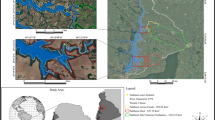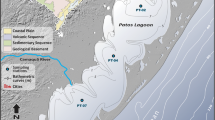Abstract
The Constant Flux: Constant Sedimentation (CF:CS) and Constant Rate of Supply (CRS) of unsupported/excess 210Pb models have been applied to a 210Pb data set providing of two sediments profiles (GUA-T1 and GUA-T2) sampled at Guarapiranga reservoir, in the Metropolitan Region of São Paulo city, São Paulo State, Brazil. Sedimentation rates obtained by the CF:CS model corresponded to 9.3–12.3 and 30 mg.cm− 2yr− 1, respectively, for profiles GUA-T1 and GUA-T2, indicating a better chronological performance relatively to that of the CRS model in the study area, also allowing successful estimates of the P fluxes in the reservoir.
Similar content being viewed by others
References
Krueger KM, Vavrus CE, Lofton ME et al (2020) Iron and manganese fluxes across the sediment-water interface in a drinking water reservoir. Water Res 182:116003
Paerl HW, Xu H, McCarthy MJ, Zhu G, Qin B, Li Y, Gardner WS (2011) Controlling harmful cyanobacterial blooms in a hyper-eutrophic lake (Lake Taihu, China): the need for a dual nutrient (N & P) management strategy. Water Res 45(5):1973–1983
Boers PCM (1991) The release of dissolved phosphorus from lake sediments. PhD Thesis, Institute for Inland Water Management and Waste Water Treatment, Lelystad, the Netherlands
Matisoff G, Kaltenberg EM, Steely RL, Hummel SK, Seo J, Gibbons KJ, Bridgeman TB, Seo Y, Behbahani M, James WF, Johnson LT, Doan P, Dittrich M, Evans MA, Chaffin JD (2016) Internal loading of phosphorus in western Lake Erie. J Great Lakes Res 42:775–788
Ogdahl ME, Steinman AD, Weinert ME (2014) Laboratory-determined phosphorus flux from lake sediments as a measure of internal phosphorus loading. J Vis Exp 85:e51617
Norgbey E, Li Y, Zhu Y, Nwankwegu AS, Bofah-Buah R, Nuamah L (2021) Seasonal dynamics of iron and phosphorus in reservoir sediments in Eucalyptus plantation region. Ecol Process 10:10
Paudel B, Weston N, O’Connor J, Sutter L, Velinsky D (2017) Phosphorus Dynamics in the Water Column and Sediments of Barnegat Bay, New Jersey. J Coast Res 78:60–69
Cherdyntsev VV (1969) Uranium-234. IPST-Israel Program for Scientific Translations, Jerusalem
Eakins JD, Morrison RT (1978) A new procedure for the determination of lead-210 in lake and marine sediments. Appl Radiat Isot 29:531–536
Kathren RL (1984) Radioactivity in the environment: sources, distribution and surveillance. Harwood Academic Publishers, New York
Abril JM (2003) Difficulties in interpreting fast mixing in the radiometric dating of sediments using 210Pb and 137Cs. J Paleolimnol 30:407–414
Abril JM (2004) Constraints on the use of 137Cs as a time-marker to support CRS and SIT chronologies. Environ Pollut 129:31–37
Spliethoff H (1996) History of toxic metal discharge to surface waters of the Aberjona watershed. Environ Sci Technol 30:121–128Hemond H ()
Celis-Hernández O, Rosales-Hoz L, Cundy AB, Carranza-Edwards A, Croudace IW, Hernandez-Hernandez H (2018) Historical trace element accumulation in marine sediments from the Tamaulipas shelf, Gulf of Mexico: an assessment of natural vs. anthropogenic inputs. Sci Total Environ 622–623:325–336
Appleby PG, Oldfield F (1992) In: Ivanovich M, Harmon RS (eds) Uranium series disequilibrium: applications to environmental problems, 2nd edn. Clarendon Press, Oxford
Turner LJ, Delorme LD (1996) Assessment of 210Pb data from Canadian lakes using the CIC and CRS models. Environ Geol 28(2):78–87
Bonotto DM, Garcia-Tenorio R (2014) A comparative evaluation of the CF:CS and CRS models in 210Pb chronological studies applied to hydrographic basins in Brazil. Appl Radiat Isot 92:58–72
San Miguel EG, Bolívar JP, García-Tenorio R, Martín JE (2001) 230Th/232Th activity ratios as a chronological marker complementing 210Pb dating in an estuarine system affected by industrial releases. Environ Pollut 112:361–368
Baskaran M, Naidu AS (1995) 210Pb-derived chronology and the fluxes of 210Pb and 137Cs isotopes into continental shelf sediments, East Chukchi Sea, Alaskan Artic. Geochim Cosmochim Acta 59(21):4435–4448
Krishnaswami S, Lal D, Martin JM, Meybeck M (1971) Geochronology of lake sediments. Earth Planet Sci Lett 11:407–414
Appleby PG, Oldfield F (1978) The calculation of 210Pb dates assuming a constant rate of supply of unsupported 210Pb to the sediment. CATENA 5:1–8
Robbins JA (1978) In: Nriagu JO (ed) Biochemistry of lead. Elsevier, Amsterdam
El-Daoushy F (1988) A summary on the lead-210 cycle in nature and related applications in Scandinavia. Environ Int 14:305–319
Kotarba A, Lokas E, Wachniew P (2002) 210Pb dating of young Holocene sediments in high-mountains lakes of the Tatra mountains. Geochronometria 21:73–78
Silva DB, Monteiro LR, Generoso MF, Bicudo C, Bicudo D, Cotrim MEB, Pires MAF (2013) Study about iron and phosphorus in waters and sediments from Guarapiranga dam, São Paulo, Brazil. In: ABRH (Brazilian Society of Hydric Resources) (ed) Proc XX Brazilian Symposium of Hydric Resources. ABRH, Bento Gonçalves (in Portuguese)
Otomo JI (2015) Anthropic contribution for the quality of waters from Guarapiranga dam – a study about edocrine disruptors. PhD Thesis, IPEN-Institute for Energetic and Nuclear Researchers, São Paulo (in Portuguese)
Whately M, Cunha PM (2006) Guarapiranga 2005 – How and why São Paulo is missing this reservoir: results of the socio-environmental participative diagnosis of the Guarapiranga hydrographic basin. ISA – Socio-environmental Institute, São Paulo. (in Portuguese)
Mozeto AA, Silvério PF, Soares A (2001) Estimates of benthic fluxes of nutrients across the sediment-water interface (Guarapiranga reservoir, São Paulo, Brazil). Sci Total Environ 266:135–142
Andrade MRM, Salim A, Rossini-Penteado D, da Costa JA, de Souza AA, Saad AR, Oliveira ASM (2015) Mapping of the land use for evaluating the water quality from Guarapiranga reservoir. Geosciences 34(2):258–275 (in Portuguese)
Bicudo CEM, Bicudo DC (2017) 100 years of Guarapiranga dam: lessons and challenges. CRV Publishers, São Paulo. (in Portuguese)
Bicudo CEM (2010) Paleolimnological reconstruction of Guarapiranga dam and diagnosis of actual quality of waters and sedimentsfrom RMSP watersheds aiming the management of the present supply. Technical Report. FAPESP – Foundation for Supporting Research at São Paulo State, São Paulo (in Portuguese)
Beyruth Z (2000) Periodic disturbances, trophic gradient and phytoplankton characteristics related to cyanobacterial growth in Guarapiranga Reservoir, São Paulo State, Brazil. Hydrobiologia 424:51–65
Fontana L, Albuquerque ALS, Brenner M, Bonotto DM, Sabaris TPP, Pires MAF, Cotrim MEB, Bicudo DC (2014) The eutrophication history of a tropical water supply reservoir in Brazil. J Paleolimnol 51:29–43
da Silva LF, Thesis (1991) UNESP-São Paulo State University, Rio Claro (in Portuguese)
Karali T, Ölmez S, Yener G (1996) Study of spontaneous deposition of 210Po on various metals and application for activity assessment in cigarette smoke. Appl Radiat Isot 47:409–411
Flynn WW (1968) The determination of low levels of polonium-210 in environmental materials. Anal Chim Acta 43:221–227
Bonotto DM (2010) The Poços de Caldas hot spot: a big blast for nuclear energy in Brazil. Nova Science, New York
Currie LA (1968) Limits for qualitative detection and quantitative determination. Anal Chem 40:586–593
Bonotto DM, Caprioglio L (2002) Radon in groundwaters from Guarany aquifer, South America: environmental and exploration implications. Appl Radiat Isot 57:931–940
Du P, Walling DE (2012) Using 210Pb measurements to estimate sedimentation rates on river floodplains. J Environ Radioact 103:59–75
Bonotto DM, Lima JLN (2006) 210Pb-derived chronology in sediment cores evidencing the anthropogenic occupation history at Corumbataí River basin, Brazil. Environ Geol 50(4):595–611
Sabaris TPP, Bonotto DM (2010) Sedimentation rates in Atibaia River basin, São Paulo State, Brazil, using 210Pb as geochronometer. Appl Radiat Isot 69:275–288
Nery JRC, Bonotto DM (2011) 210Pb and composition data of near-surface sediments and interstitial waters evidencing anthropogenic inputs in Amazon River mouth, Macapá, Brazil. J Environ Radioact 102:348–362
Matamet FRM, Bonotto DM (2013) Evaluation of the chromium contamination at Ribeirão dos Bagres, Franca (SP), Brazil, by the 210Pb method. Appl Radiat Isot 82:359–369
Bonotto DM, Vergotti M (2015) 210Pb and compositional data of sediments from Rondonian lakes, Madeira River basin, Brazil. Appl Radiat Isot 99:5–19
Matamet FRM, Bonotto DM (2018) A 210Pb chronological study in sediments from Poços de Caldas Alkaline Massif (PCAM), Brazil. Appl Radiat Isot 137:108–117
Matamet FRM, Bonotto DM (2019) Sedimentation rates at Ramis River, Peruvian Altiplano, South America. Environ Earth Sci 78:230
Matamet FRM, Bonotto DM (2019) Identifying sedimentation processes in the Coata River, Altiplano of the Puno Department, Peru, by the 210Pb method. Environ Earth Sci 78:641
Bonotto DM, Garcia-Tenorio R (2019) Investigating the migration of pollutants at Barreiro area, Minas Gerais State, Brazil, by the 210Pb chronological method. J Geochem Explor 196:219–234
Bonotto DM (2020) Tracking pollutants in selected Brazilian drainages from Araxá city. Appl Radiat Isot 155:108916
Udden JA (1898) Mechanical composition of wind deposits. Augustana Libr Publ 1:1–69
Wentworth CK (1922) A scale of grade and class terms for clastic sediments. Jour Geol 30:377–392
Krumbein WC (1934) Size frequency distributions of sediments. J Sediment Petrol 4:65–77
Wanty RB, Lawrence EP, Gundersen LCS (1992) In: Gates AE, Gundersen LCS (eds) Geologic controls on radon. Geol Soc Am, Boulder
Santschi PH, Presley BJ, Wade TL, Garcia-Romero B, Baskaran M (2001) Historical contamination of PAHs, PCBs, DDTs, and heavy metals in Mississippi River Delta, Galveston Bay and Tampa Bay sediment cores. Mar Environ Res 52:52–79
Carpenter SR (2008) Phosphorus control is critical to mitigating eutrophication. Proc Natl Acad Sci USA 105(32):11039–11040
Heisler J, Glibert PM, Burkholder JM, Anderson DM, Cochlan W, Dennison WC, Dortch Q, Gobler CJ, Heil CA, Humphries E, Lewitus A, Magnien R, Marshall HG, Sellner K, Stockwell DA, Stoecker DK, Suddleson M (2008) Eutrophication and harmful algal blooms: a scientific consensus. Harmful Algae 8(1):3–13
Figueredo CC, Pinto-Coelho RM, Lopes AMMB, Lima PHO, Gücker B, Giani A (2016) From intermittent to persistent cyanobacterial blooms: identifying the main drivers in an urban tropical reservoir. J Limnol 75(3):445–454
Schindler DW (2012) The dilemma of controlling cultural eutrophication of lakes. Proc R Soc B Biol Sci 279(1746):4322–4333
Clavero V, Izquierdo JJ, Fernández JA, Niell FX (2000) Seasonal fluxes of phosphate and ammonium across the sediment-water interface in a shallow small estuary (Palmones River, southern Spain). Mar Ecol Prog Ser 198:51–60
Khalil MK, Rifaat AE (2013) Seasonal fluxes of phosphate across the sediment-water interface in Edku Lagoon. Egypt Oceanologia 55(1):219–233
Dadi T, Rinke K, Friese K (2020) Trajectories of Sediment-Water Interactions in Reservoirs as a Result of Temperature and Oxygen Conditions. Water 12:1065
Papera J, Araújo F, Becker V (2021) Sediment phosphorus fractionation and flux in a tropical shallow lake. Acta Limnol Bras 33:e5
Acknowledgements
The authors thank FAPESP (Foundation for Supporting Research at São Paulo State) for supporting this study by AcquaSed Project (Process No. 2009/53898-9). Two anonymous reviewers are greatly thanked for helpful comments that improved the readability of the manuscript.
Author information
Authors and Affiliations
Corresponding author
Ethics declarations
Declaration on conflict of interest
The authors declare that they have no known competing financial interests or personal relationships that could have appeared to influence the work reported in this paper.
Additional information
Publisher’s note
Springer Nature remains neutral with regard to jurisdictional claims in published maps and institutional affiliations.
Rights and permissions
About this article
Cite this article
Bonotto, D.M., Sabaris, T.P.P., Bicudo, D.C. et al. Sediments accretion at Guarapiranga reservoir, metropolitan region of São Paulo, Brazil, by the 210Pb chronological method. J Radioanal Nucl Chem 331, 2869–2882 (2022). https://doi.org/10.1007/s10967-022-08382-2
Received:
Accepted:
Published:
Issue Date:
DOI: https://doi.org/10.1007/s10967-022-08382-2









